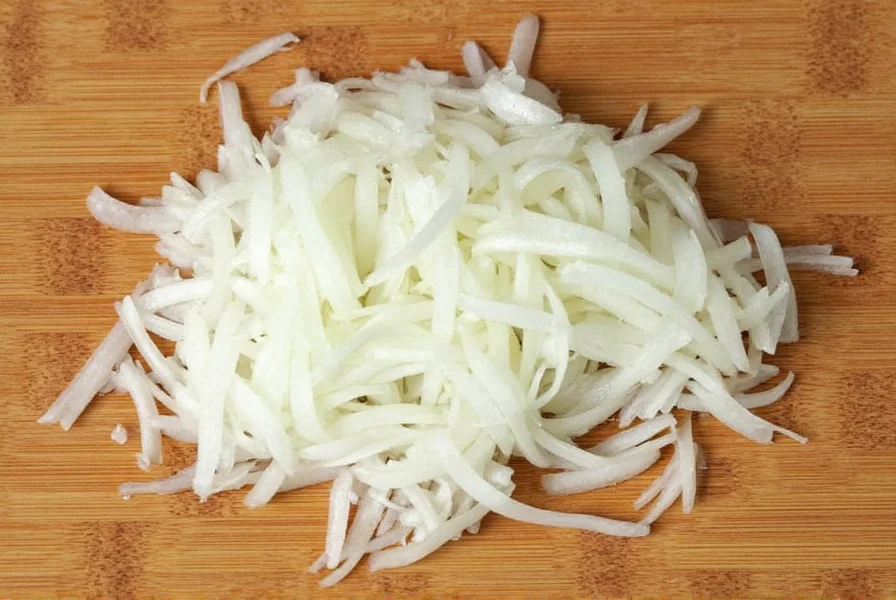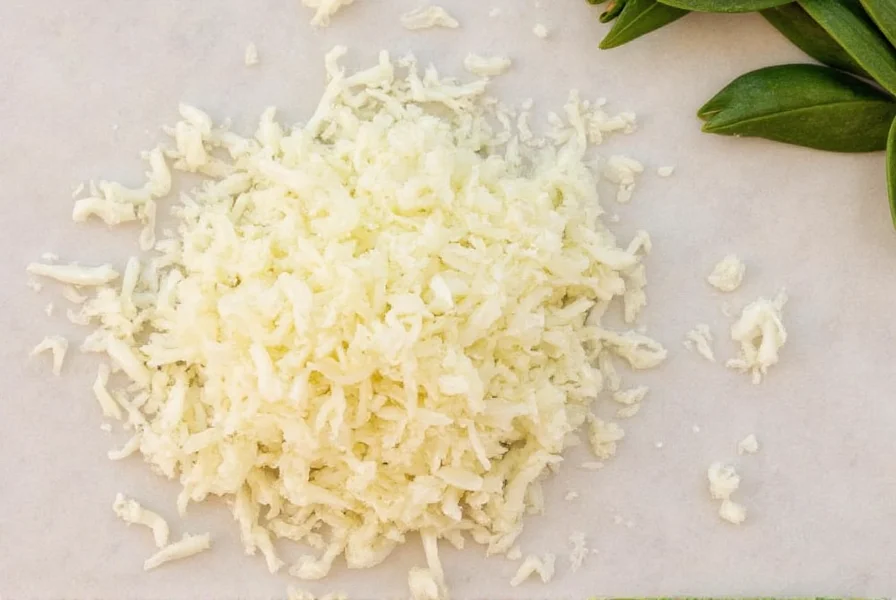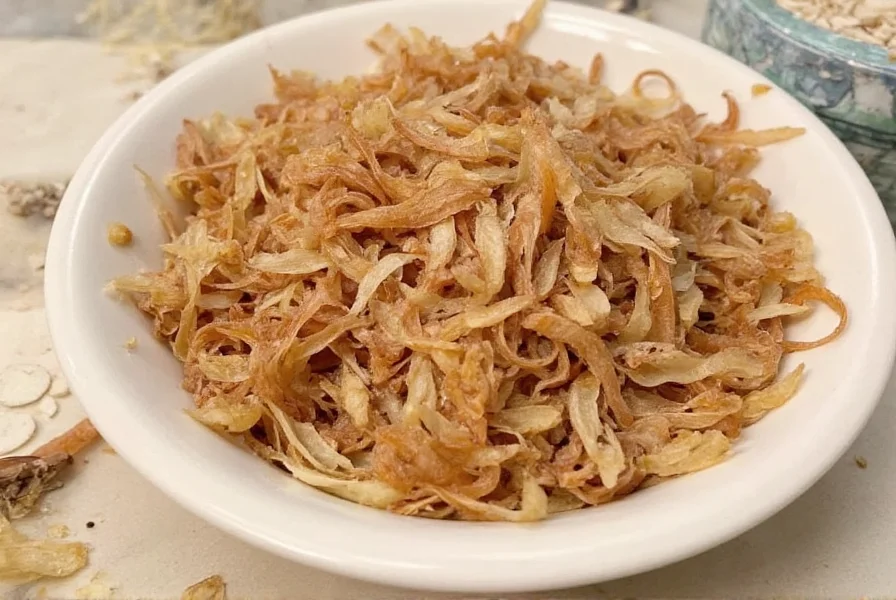3 tablespoons of dried minced onion equals 1 medium fresh onion. This conversion ratio accounts for the moisture loss during dehydration, which concentrates the onion's flavor and reduces its volume significantly.
When substituting dried minced onion for fresh in recipes, understanding the precise conversion is essential for maintaining balanced flavors. Many home cooks struggle with this substitution, often resulting in dishes that are either too mild or overpoweringly onion-flavored. The standard conversion—3 tablespoons dried minced onion for 1 medium fresh onion—provides the most accurate flavor equivalent in most culinary applications.
Why the 3:1 Conversion Ratio Works
Dehydrated onions undergo a process that removes approximately 85-90% of their natural moisture content. This dramatic reduction explains why such a small amount of dried product equals a whole fresh onion. During dehydration, water evaporates while flavor compounds concentrate, creating a more potent product by volume.
Culinary scientists have determined that a medium-sized onion (about 5 ounces or 140 grams) yields approximately 3 tablespoons of dried minced onion after complete dehydration. This ratio maintains flavor equilibrium in most recipes when properly rehydrated or incorporated directly into dishes with sufficient liquid.
Detailed Onion Conversion Chart
| Fresh Onion Size | Weight (Approx.) | Diced Volume | Dried Minced Onion Equivalent |
|---|---|---|---|
| Small onion | 3-4 oz (85-115g) | ½ cup diced | 2 tablespoons |
| Medium onion | 5 oz (140g) | 1 cup diced | 3 tablespoons |
| Large onion | 6-8 oz (170-225g) | 1½ cups diced | 4½ tablespoons |
| Jumbo onion | 8-12 oz (225-340g) | 2 cups diced | 6 tablespoons (¼ cup) |
Practical Substitution Techniques
Successfully substituting dried minced onion for fresh requires more than just measurement conversion. Consider these professional techniques:
- Rehydration method: For dishes with minimal liquid, reconstitute dried minced onion by mixing with 2-3 tablespoons of warm water per 3 tablespoons of dried product. Let stand for 10-15 minutes before adding to your recipe.
- Direct addition: In soups, stews, and sauces with ample liquid, add dried minced onion directly to allow gradual rehydration during cooking.
- Flavor adjustment: Taste after 75% of cooking time and adjust seasoning, as dried onion's flavor intensifies as it rehydrates.
- Texture consideration: Remember that dried minced onion won't provide the same textural element as fresh, which matters in dishes like salsas or salads.

When Fresh and Dried Aren't Perfect Substitutes
While the 3:1 ratio works well for most cooked applications, certain recipes don't translate perfectly between fresh and dried forms:
Recipes where fresh onion is essential include raw applications like salads, salsas, and garnishes where texture and sharp bite matter. Dishes relying on onion's natural moisture content, such as certain meatloaves or veggie burgers, may become too dry when using only dried product.
Conversely, dried minced onion excels in spice blends, dry rubs, and long-cooked dishes where fresh onion would break down completely. It's also ideal for emergency cooking when fresh produce isn't available.
Avoiding Common Substitution Mistakes
Many cooks make these critical errors when substituting dried for fresh onions:
- Using equal volumes: Treating 1 cup dried minced onion as equivalent to 1 cup fresh creates overwhelmingly strong flavor.
- Ignoring rehydration needs: Adding dried onion directly to low-moisture recipes results in unpleasant texture and uneven flavor distribution.
- Not adjusting cooking time: Dried onion reaches full flavor potential faster than fresh, so add it later in the cooking process for some dishes.
- Overlooking salt content: Some commercial dried minced onions contain anti-caking agents with salt, requiring adjustment to overall recipe salt.
Storage and Shelf Life Considerations
Understanding shelf life differences helps maximize your onion investments. Properly stored in an airtight container away from light and moisture, dried minced onion maintains peak quality for 12-18 months. Fresh onions, by contrast, last 2-4 weeks under optimal conditions (cool, dark, ventilated space).
When converting measurements for older dried onion products, consider that flavor potency diminishes over time. For dried onion stored more than 6 months, increase the measurement by 25% to compensate for flavor degradation.

Professional Chef Recommendations
Many professional chefs maintain both fresh and dried onion products for different applications. For emergency substitutions, they recommend:
- Creating a quick rehydration mixture with dried minced onion, water, and a pinch of sugar to mimic fresh onion's natural sweetness
- Adding dried minced onion in stages during cooking rather than all at once
- Combining dried minced onion with a small amount of onion powder for more complex flavor in long-cooked dishes
- Using frozen diced onions as an intermediate option when fresh isn't available but dried seems too intense
Remember that personal taste preferences affect ideal conversion ratios. Some palates detect onion flavor more acutely than others, so adjust according to your household's preferences while using the 3:1 ratio as your starting point.
Can I use onion powder instead of dried minced onion in the same measurements?
No, onion powder is more concentrated than dried minced onion. Use 1 tablespoon onion powder for every 3 tablespoons dried minced onion, or 1 teaspoon onion powder to replace 1 medium fresh onion.
Does the conversion ratio change for different onion varieties?
The 3:1 ratio (3 tablespoons dried minced onion = 1 medium fresh onion) applies to yellow cooking onions, which are most commonly used in recipes. For stronger varieties like red onions, reduce the dried amount by 25%, while for milder varieties like Vidalias, you might need to increase by 25%.
How do I adjust recipes when converting from dried to fresh onions?
When substituting fresh for dried, use 1 cup diced fresh onion per 3 tablespoons dried minced onion. Remember to account for the additional moisture content, which may require slight adjustments to other liquid ingredients in baking recipes.
Why does my dish taste too strong when I use the recommended conversion?
Several factors could cause this: your dried onion might be older (older product often develops stronger flavor), you may be using a different onion variety than the recipe assumes, or your personal taste sensitivity to onion differs. Start with 2½ tablespoons dried minced onion per medium fresh onion and adjust to taste.
Can I make my own dried minced onion at home?
Yes, thinly slice fresh onions and dehydrate at 140°F (60°C) until completely brittle (about 8-12 hours). The homemade conversion remains 3 tablespoons dried = 1 medium fresh onion, but homemade versions often have more nuanced flavor than commercial products.
Final Conversion Tips for Perfect Results
Mastering the dried minced onion to fresh onion conversion opens up culinary flexibility while maintaining recipe integrity. Keep these final tips in mind:
- Always measure dried minced onion with a proper tablespoon measure—don't eyeball it
- For critical recipes, prepare a small test batch with your converted measurements first
- Consider the dish's cooking time—longer cooking allows more complete rehydration of dried products
- When in doubt, start with slightly less dried onion and add more during cooking
Understanding how much dried minced onion equals 1 onion transforms your cooking experience, allowing seamless adaptation between fresh and shelf-stable ingredients without compromising flavor balance. This knowledge proves invaluable when recipe ingredients don't match what's available in your pantry.











 浙公网安备
33010002000092号
浙公网安备
33010002000092号 浙B2-20120091-4
浙B2-20120091-4